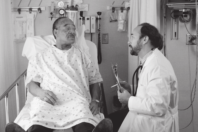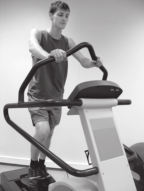• Hormones
• Food
• Being
healthy
• Adult
support
• Diseases
• Shelter
• Making
friends
• Family
values
• Puberty
• Clothing
• Grades
• Culture
• Health
• Social
interactions
• Popularity
• Sibling
rivalry
• Disabilities/
• Affection
• Image
• Religion
handicaps
• Success
• Morals
Environment/
Resources
Media
Social
Community
• Money
• TV
• Peers
• Neighborhood
• Time
• Video
games
• Teachers
• Weather
• Educational
• Magazines
• Sports
teams/clubs
• Playgrounds/parks
opportunities
• Movies
• Cliques
• Transportation
• Transportation
• Music/music
videos
• Mentors/role
models • Policies/laws
• Sports
• Friends
• Culture
• Advertisements
4 Behavioral and Social Science Research
during adolescence and contribute to chronic
and Cardiovascular Disease
diseases Americans face today:
In this curriculum supplement, students
• tobacco use (smoking, chewing);
role-play behavioral clinicians in a scenario
• dietary behaviors (food selection, portion-
involving a patient with heart disease. Heart
size selection, attitudes toward foods and
disease is a collection of conditions that
eating);
limit the flow of blood to the heart muscle
• physical activity (type, intensity, duration,
itself, including atherosclerosis, angina, and
frequency);
heart attack. Together, heart disease and
• alcohol and other drug use;
stroke, which is a loss of blood flow to the
• sexual behaviors (leading to acquiring
brain, comprise the main components of
sexually transmitted diseases, unwanted
cardiovascular disease (CVD). Over 930,000
pregnancies); and
people in the United States die annually as a
• behaviors that may result in violence and
result of cardiovascular disease, and 64 million
unintentional injuries (use of weapons,
Americans suffer from cardiovascular disease.7
motor vehicles).
CVD has traditionally been a disease of older
people; however, recently, the incidence of
Due to large-scale public education efforts,
heart disease in younger people has risen.
most people, even adolescents, are aware of the
risks unhealthy behaviors pose to their health,
4.1 Health Outcomes of Behavior
yet they continue to engage in these behaviors.
Heart disease and stroke share several of
the same risk factors, many of which are
Most people, even adolescents, are aware
preventable. These are the same factors that
of the risks unhealthy behaviors pose to
contribute to other chronic diseases, such as
their health, yet they continue to engage in
diabetes, which can complicate treatment and
these behaviors.
research. The CDC has identified a limited
number of behaviors that are often established
28


A variety of influences contributes to an
4.2 Identifying Behavioral Trends, Risky
individual’s decision to engage in unhealthy
Behaviors, and At-Risk Groups
behaviors or avoid them. Among these is an
Behavioral and social science research
individual’s perception of long- and short-
contributes to health care by identifying
term health risks. Behaviors with short-term,
potential health problems, studying risky
or more immediate, health risks may be less
behaviors, and evaluating the efficacy of
appealing than behaviors with long-term risks.
treatments. The influences on the patient’s
For example, while an individual might not
health-related behaviors are similar to the
refrain from overindulging in alcohol due to
influences on any behavior. For example,
long-term consequences, such as addiction or
genetics, family and cultural norms, and the
liver disease, he or she might refrain to avoid
media play roles in an individual’s behaviors.
being ill immediately.
Research in behavioral and social sciences
Many people, especially adolescents, believe
examines healthcare data to determine the
long-term health consequences can be avoided
trends in health-related behaviors, including
by a vague plan to change the behavior “later.”
the prevalence of unhealthy behaviors and who
These expectations of changing behaviors
is at risk. The research examines the influences
can be unrealistic since changing behaviors is
that play major roles in these behaviors
difficult. For example, 79 percent of smokers
and that can enhance the effectiveness of
relapse after quitting.3
prevention programs or medical treatments by
determining how to reduce negative influences
and enhance beneficial ones. This research can
help the healthcare industry identify where
to concentrate preventive efforts or how to
prepare for upcoming health needs.
Epidemiological reports, such as the American
Heart Association’s (AHA’s) annual report on
CVD, reveal disease trends in the population.1
The AHA report, a statistical analysis of CVD
in the United States, provides information on
the incidence of CVD, treatments, and at-risk
populations. Studies of risk behaviors can
identify groups that are more likely to develop
CVD. Another report examined the connection
between smoking prevalence and levels of
education and income.17
Healthcare workers with epidemiological
information can target at-risk groups for
maximal impact of preventive and early care.
For example, a 1999 study showed that men
whose parents suffered from CVD developed
atherosclerosis at a high rate.27 This was not
a surprise, based on genetics; however, the
Figure 4. Engaging in unhealthy behaviors is
behavioral aspect of the research indicated
influenced by the perception of long- and short-
that stress was a major factor in triggering
term risks.
atherosclerosis in these patients. The
29
Information about the Science of Healthy Behaviors


The Science of Healthy Behaviors
behavioral factor was unexpected and can be
used to select appropriate preventive treatments
for this group of patients.
4.3 Behavioral Interventions
When patients develop diseases with strong
behavioral components, such as cardiovascular
disease, behavioral interventions are often
recommended in addition to medical
treatments. In chronic diseases strongly
affected by behavior, changing behavior can
help control the disease. Behavioral and social
science research has provided many new
nondrug interventions for managing chronic
diseases, thus preventing the development
of new diseases and promoting healthy
behaviors.22
Behavioral and social science research has
provided many new nondrug interventions
for managing chronic diseases.
Interventions address self-efficacy or self-
confidence issues, provide problem-solving skills,
and promote the development of social support
Figure 5. Behavioral interventions help patients
systems. Successful interventions take into
with heart disease improve their health.
account various influences in the patient’s life
and involve individual, family, and community
needed. Follow-up care with the primary care
organizations in behavioral modification.10
provider is an important part of treating any
chronic disease.4
Behavioral intervention is an approach to
addressing a behavior that has poor health
outcomes and replacing it with a more
4.4 Maximizing Effective Medical and
productive behavior. The primary care
Behavioral Treatments
provider, such as a physician, nurse midwife,
Studying how patients deal with chronic
or nurse practitioner, works with the patient to
disease is an important component of
design an initial behavioral intervention plan.
developing effective medical and behavioral
First, the patient’s readiness for change may
treatments. Hostility, depression, and stress
be assessed, as well as the patient’s views on
play major roles in the progression of many
how important the change is and how likely
chronic diseases.12 One important reason for
he or she is to succeed. The patient’s medical
a behavioral intervention approach is that
and behavioral history is reviewed to identify
the patient is largely responsible for the day-
problem behaviors, such as smoking or not
to-day treatment of chronic illness. This can
exercising. This process involves input by
be an overwhelming task without the proper
both patient and care provider, and leads to
preparation and support.
the development of a behavioral modification
plan.9 The patient may be referred to behavioral
Although a patient may be highly motivated to
therapists and other healthcare professionals as
change, many factors are involved in successful
30
behavior change. In addition to learning about
4.5 Behavioral and Social Science
healthy and unhealthy behaviors, patients need
Research and Public Health
to learn new skills and new behaviors, such
Behavioral interventions can be provided
as self-monitoring.26 Other important factors
as informational programs, behavioral and
include social support and self-confidence.
social interventions, or environmental and
policy approaches.11 Because the response
Patients who have been diagnosed with
to behavioral treatments can vary among
chronic diseases react differently to sudden
demographic groups, meta-analysis of programs
requirements to change lifelong behaviors.
is a useful tool. In meta-analyses, researchers
Some may succeed in changing their behaviors
compare the results of several similar studies or
on their own; many others will be only
programs. This allows the researchers to draw
partially successful or even fail completely.
conclusions about the general applicability of
Behavioral and social science research can
various approaches to determine whether one
analyze these outcomes to determine what
approach is more effective than another or
generates successes and failures, giving
whether effectiveness depends on the target
healthcare providers more information for
audience.
successful treatment of their patients.
Meta-analyses of risk factors and behavioral
Approaches to changing behaviors include
interventions provide a summary of findings
participating in formal programs or support
for practitioners. For example, the Guide
groups and individualized therapy. Many
to Community Preventive Services offers
health maintenance organizations (HMOs)
continually updated summaries of a variety
and other healthcare groups provide
of public health interventions.11 Practitioners
classes, seminars, and printed materials to
can look up the behavior of interest, see what
encourage healthy behaviors. Private groups
programs have been scientifically tested for
offer programs designed to change specific
effectiveness, and determine which might be
habits, such as how to lose weight or stop
most appropriate for their community. A recent
smoking. One important aspect of behavioral
review examined the effectiveness of media
intervention is having a long-term approach.
campaigns and summarized the important
Realistic goal setting, support from friends and
points for an effective campaign based on a
family, and adding healthy behaviors before
scientific analysis of this type of campaign.23
removing unhealthy behaviors all increase
Meta-analysis ensures that evidence-based
success rates.9, 10 The experience of “going cold
methods are available to practitioners, which
turkey” may work for some individuals, but
reduces wasted time, effort, and money.
most need to pursue a more gradual approach.
In addition to studying the effectiveness of
Alternative treatments such as yoga, medi-
programs, specifically whether or not the
tation, acupuncture, and biofeedback may be
program resulted in the proposed outcomes,
successful for some patients.14 Behavioral and
social science also examines feasibility of
social sciences research can be translated into
programs.2 This is particularly important
effective behavioral interventions and thus
for public health programs, in which a wide
complement or enhance the effectiveness of
audience is targeted with limited funds. Social
medical treatment of chronic diseases.
science research can provide information about
31
Information about the Science of Healthy Behaviors
The Science of Healthy Behaviors
which program is most likely to be effective
4.6 The Science of Healthy Behaviors
in a particular community. For example, the
In this curriculum supplement, students are
Guide to Community Preventive Services offers
introduced to the complexities of studying
information on effective interventions on a
behaviors. Learning how to understand
variety of levels, and also provides information
behaviors on a scientific level and deriving
about the cost-effectiveness of these programs.11
practical healthcare applications is a complex
An affordable program may not be effective, or a
but effective process. Through playing the roles
very effective program may require high funding
of professionals, students should become aware
levels and, therefore, be impractical. In addition,
that behaviors can be studied and that there is a
information about the community to be served,
scientific basis to behavioral intervention. They
such as local risk factors, community priorities,
should also learn about the many influences
and local resources, is critical to ensure an
on behavior and how an individual can modify
appropriate choice for a given community.2
behavior. Through their increased understanding
of behavior, they should come to understand
Another important consideration in developing
that changing behaviors “later” is not a good
behavioral health programs is cultural
plan, or an easy task. In addition, they should
sensitivity.13 Effective programs must be
become aware of the many factors that increase
culturally accessible, using people, language,
the likelihood of successful behavior changes.
and clothing with which the target audience
Students should be able to apply these behavioral
can identify. In addition, a deeper sense of
and social science concepts to their own lives,
culture that takes into account traditions
thus improving their own chances of successfully
and history will increase the effectiveness
practicing healthy behaviors.
of programs.24 For example, in one study on
improving nutrition in a black population, the
5 Web Resources
intervention was based in black churches. The
The following Web sites contain information
churches proved to be an effective location for
that may be useful to you:
intervention efforts for this community.25
• http://ninr.nih.gov/ninr
• http://obssr.od.nih.gov
Effective programs must be culturally
• http://www.nhlbi.nih.gov/health/public/heart/
accessible, using people, language, and
index.htm
clothing with which the target audience
can identify.
32
References
1. American Heart Association. 2004. Heart
7. Centers for Disease Control and Prevention.
Disease and Stroke Statistics—Updates,
2004. Preventing heart disease and stroke:
2004. Retrieved November 5, 2004,
Addressing the nation’s leading killers.
from the World Wide Web: http://www.
Retrieved November 4, 2004, from the
americanheart.org/downloadable/heart/
World Wide Web: http://www.cdc.gov/
1075102824882HDSStats2004UpdateREV1-
nccdphp/aag/aag_cvd.htm. Update available
23-04.pdf
at http://www.cdc.gov/nccdphp/publications/
aag/cvh.htmI (April 2006).
2. Briss, P.A., Brownson, R.C., Fielding, J.E.,
and Zaza, S. 2004. Developing and using
8. Committee on Health and Behavior:
the Guide to Community Preventive Services:
Research, Practice, and Policy, Board on
Lessons learned about evidence-based
Neuroscience and Behavioral Health,
public health. Annual Review of Public
Institute of Medicine. 2001. Health and
Health, 25: 281−302.
Behavior: The Interplay of Biological,
Behavioral, and Social Influences.
3. Burke, L.E., Dunbar-Jacob, J.M., and Hill,
Washington, D.C.: National Academy Press.
M.N. 1997. Compliance with cardiovascular
disease prevention strategies: A review of
9. Feinstein, R.E., and Feinstein, M.S. 2001.
the research. Annals of Behavioral Medicine,
Psychotherapy for health and lifestyle
19: 239−63.
change. Journal of Clinical Psychology/In
Session, 57: 1263−1275.
4. Center for the Advancement of Health.
2000. Health Behavior Change in Managed
10. Gotay, C.C. 2005. Behavior and cancer
Care. Washington, D.C.: Center for the
prevention. Journal of Clinical Oncology,
Advancement of Health. Retrieved March
23: 301−10.
28, 2005, from http://www.cfah.org/pdfs/
health_monograph.pdf
11. Guide to Community Preventive Health.
2004. Retrieved November 5, 2004,
5. Center for the Advancement of Health.
from the World Wide Web: http://www.
2000. Selected evidence for behavioral
thecommunityguide.org/pa/default.htm
approaches to chronic disease management:
Cardiovascular disease. Retrieved
12. Krantz, D.S., and McCeney, M.K. 2002.
November 4, 2004, from the World Wide
Effects of psychological and social factors
Web: http://www.cfah.org/pdfs/health_topic_
on organic disease. Annual Review of
cardio.pdf
Psychology, 53: 341−369.
6. Centers for Disease Control and Prevention.
13. Kreuter, M.W., and McClure, S.M.
2003. Chronic disease prevention: Chronic
2004. The role of culture in health
disease overview. Retrieved June 17, 2003,
communication. Annual Review of Public
from the World Wide Web: http://www.cdc.
Health, 25: 439−455.
gov/nccdphp/overview.htm
33
The Science of Healthy Behaviors
14. Labarthe, D., and Ayala, C. 2002. Nondrug
22. Office of Behavioral and Social Sciences
interventions in hypertension prevention
Research. 2004. Information for the public.
and control. Cardiology Clinics, 20: 249−63.
Retrieved November 3, 2004, from the
World Wide Web; now available through
15. Loucks-Horsley, S., Hewson, P., Love, N.,
http://obssr.od.nih.gov/Content/Research/
and Stiles, K. 1998. Designing Professional
BSSR_Guide_To_Grants_at_NIH/
Development for Teachers of Science and
Mathematics. Thousand Oaks, CA: Corwin
23. Randolph, W., and Viswanath, K. 2004.
Press.
Lessons learned from public healt







